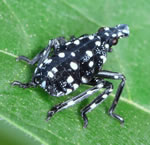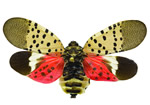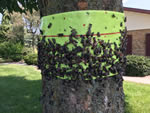 The tiny, white-flecked black nymphs showed up around mid-May in backyards, right about where the adults of their ilk had swarmed the grapevines last fall. Scraping egg masses off the nearby maple tree apparently didn’t do the trick to eradicate them.
The tiny, white-flecked black nymphs showed up around mid-May in backyards, right about where the adults of their ilk had swarmed the grapevines last fall. Scraping egg masses off the nearby maple tree apparently didn’t do the trick to eradicate them.
They’re the spotted lanternfly, and they’re back tightening their grip on southeastern Pennsylvania and New Jersey. It’s the early nymph, or instar, stage crawling around now. By July, the mostly-black-with-white-spot bodies will molt into a pattern of red, black, and white. The adult form that hops around, hitching rides and laying eggs, can be found from mid-summer into December.
 “The only good lanternfly is a dead one and I applaud everybody’s efforts to help with the spotted lanternfly effort, but we want to be smart in doing so. The spotted lanternfly poses a significant threat to $18 billion worth of Pennsylvania agriculture products, including the grape, hops, tree-fruit, hardwood, and nursery industries. Its piercing-sucking mouthpart damages plant-hosts by feeding, and the insects excrete sugary waste called honeydew that fosters sooty mold that, in turn, can keep plants from photosynthesizing.
“The only good lanternfly is a dead one and I applaud everybody’s efforts to help with the spotted lanternfly effort, but we want to be smart in doing so. The spotted lanternfly poses a significant threat to $18 billion worth of Pennsylvania agriculture products, including the grape, hops, tree-fruit, hardwood, and nursery industries. Its piercing-sucking mouthpart damages plant-hosts by feeding, and the insects excrete sugary waste called honeydew that fosters sooty mold that, in turn, can keep plants from photosynthesizing.
Tree-banding works to trap the nymphs as they crawl up trunks to feast on soft, new growth. This is a non-insecticidal method of killing them, and it doesn’t have to be anything fancy: a strip of duct tape wrapped around the trunk with the sticky side out will do the trick.
 Those who buy sticky tree bands made just for killing lanternflies can limit their effect on other, more beneficial insects by cutting them in half widthwise. Also, chicken wire wrapped around the sticky band will help prevent birds and other animals from getting stuck. But what about if the nymphs are in, say, a honeysuckle bush that doesn’t lend itself as well to tree-banding? You could try mechanical control, i.e., swatting them.
Those who buy sticky tree bands made just for killing lanternflies can limit their effect on other, more beneficial insects by cutting them in half widthwise. Also, chicken wire wrapped around the sticky band will help prevent birds and other animals from getting stuck. But what about if the nymphs are in, say, a honeysuckle bush that doesn’t lend itself as well to tree-banding? You could try mechanical control, i.e., swatting them.
If you experience an influx of insects around your home, call the experts at Universal Pest Services (610)449-0740 and schedule a free inspection today!